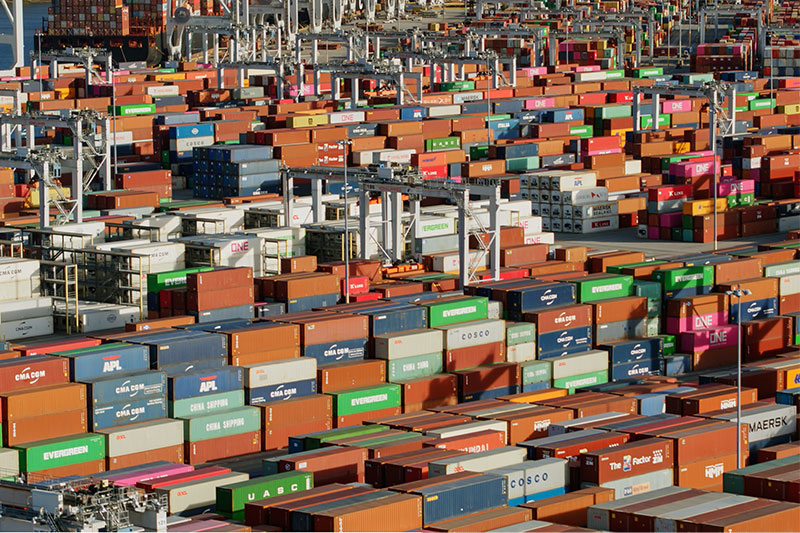Port Tracker points to U.S.-bound import gains in the coming months

United States-bound retail container import volumes appear to be trending in the right direction, with monthly volumes pegged to be around 2 million TEU (Twenty-Foot Equivalent Units) in September, for the second consecutive month, according to the Port Tracker report, which was issued today by the National Retail Federation (NRF) and maritime consultancy Hackett Associates.
The ports surveyed in the report include: Los Angeles/Long Beach; Oakland; Tacoma; Seattle; Houston; New York/New Jersey; Hampton Roads; Charleston, and Savannah; Miami; Jacksonville; and Fort Lauderdale, Fla.-based Port Everglades.
Authors of the report explained that cargo import numbers do not correlate directly with retail sales or employment because they count only the number of cargo containers brought into the country, not the value of the merchandise inside them, adding that the amount of merchandise imported provides a rough barometer of retailers’ expectations.
“These are strong numbers and a sign that retailers are optimistic about the holiday season since they don’t import merchandise unless they think they can sell it,” NRF Vice President for Supply Chain and Customs Policy Jonathan Gold said in a statement. “The holiday season is now the top priority for everyone in the retail supply chain as merchants prepare for the rush of shoppers who will soon be buying gifts for friends and family. As the holidays approach, the recent ratification of the West Coast port labor agreement between the ILWU and PMA provides supply chain stability and certainty for retailers utilizing the West Coast ports.”
For July, the most recent month for which data is available, Port Tracker reported that import volume, for the ports covered in the report, came in at 1.91 million TEU, a 4.4% increase over June and a 12.4% annual decrease.
Port Tracker issued projections for August and the subsequent months, including:
- August, at 2 million TEU, for an 11.4% annual decrease, but the first month to hit 2 million going back to October 2022;
- September and October each coming in at 2 million TEU, for a 1.8% annual decline and 0.1% annual gain, respectively;
- November, at 1.96 million TEU, for a 10.4% annual increase;
- December, at 1.94 million TEU, for a 12% annual increase; and
- January, at 1.91 million TEU, for a 5.4% annual increase
Should these projections come to fruition, total 2023 U.S.-bound container import volume would come in at 22.3 million TEU, which would represent a 12.5% annual decline compared to 2022’s 25.5 million TEU. The 2022 total was off 1.2% compared to the all-time record set in 2021, at 25.8 million TEU. These tallies came with the caveat that Canada’s Vancouver and Prince Rupert aren’t included in those totals and not all of their cargo comes to the United States.
Hackett Associates Founder Ben Hackett observed that a restriction on the maximum draft of ships passing through the Panama Canal imposed this summer after drought conditions resulted in lower water levels has not materialized into the threat some had feared. With many ships carrying less-than-capacity loads or returning empty containers, most have been able to comply with the restriction and those awaiting passage as of mid-August were expected to complete their voyages without delay.
“We have closely followed conditions at the Panama Canal,” Hackett said. “It now appears, however, that the situation has had little impact on the retail supply chain and is unlikely to be a problem as we head into the peak shipping season.”

Article Topics
3PL News & Resources
Port Tracker report is bullish on import growth over the balance of 2024 National diesel average falls for the fourth consecutive week, reports EIA New Descartes’ study examines consumer preferences, changes, and shifts in e-commerce home delivery preferences Potential Canadian rail strike could damage the country’s economy C.H. Robinson highlights progress of its AI-focused offerings with a focus on automating shipping processes UPS announces CFO Newman to leave company, effective June 1 April Services PMI contracts after 15 months of growth, reports ISM More 3PLLatest in Logistics
Port Tracker report is bullish on import growth over the balance of 2024 Varying opinions on the tracks regarding STB’s adopted reciprocal switching rule National diesel average falls for the fourth consecutive week, reports EIA New Descartes’ study examines consumer preferences, changes, and shifts in e-commerce home delivery preferences Potential Canadian rail strike could damage the country’s economy C.H. Robinson highlights progress of its AI-focused offerings with a focus on automating shipping processes UPS announces CFO Newman to leave company, effective June 1 More LogisticsAbout the Author
Subscribe to Logistics Management Magazine

Find out what the world's most innovative companies are doing to improve productivity in their plants and distribution centers.
Start your FREE subscription today.
May 2024 Logistics Management

Latest Resources














